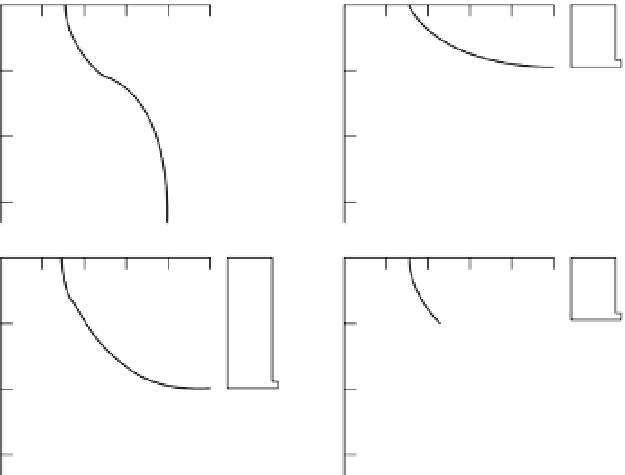Environmental Engineering Reference
In-Depth Information
Figure 5.13
Idealized
pressure-head depth profiles
in: (a) undisturbed soil; (b)
shallow lysimeter with free
drainage bottom; (c) deep
lysimeter with free drainage
bottom; and (d) shallow
lysimeter with tension
controlled bottom drain (after
van Bavel,
1961
).
Pressure head (m)
-4
-3
-2
-1
0
-4
-3
-2
-1
0
0
1
lysimeter
2
3
(a)
(b)
0
1
lysimeter
2
lysimeter
3
(c)
(d)
zone (Kitching and Shearer,
1982
; Gee
et al
.,
1994
; Gburek and Folmar,
1999
; Brye
et al
.,
2000
; Scanlon
et al
.,
2005
; Fayer and Gee,
2006
;
Heppner
et al
.,
2007
; Gee
et al
.,
2009
). Surface
areas of lysimeters can range from less than
0.1 m
2
(Evett
et al
.,
1995
) to more than 100 m
2
(Tyler
et al
.,
1992
). For studies of evapotranspir-
ation, the rate of change in water storage in
the lysimeter is required. This is usually deter-
mined by weighing the lysimeter at regular
time intervals. For recharge studies, the rate
of water drainage out the bottom of the lysim-
eter is the component of interest.
Careful design, construction, and mainte-
nance of a lysimeter are essential for obtain-
ing accurate measurements. Ideally, a surface
lysimeter consists of a block of undisturbed
soil. Excavating a large soil block is expensive
and requires great care. Some large-scale lysim-
eters are built in place by driving sidewalls
downward from land surface and sealing the
bottom through an access tunnel. When it is
not feasible to obtain an undisturbed block of
soil, lysimeters are repacked with soils, layer
by layer, each to its original bulk density, so
that it closely resembles the natural profile.
The top of the lysimeter should be flush with
the soil surface. To avoid the introduction of
artificial water-flow patterns, the surface
area should be large enough to remove any
“edge” effects introduced by the border of the
lysimeter. Vegetation in the lysimeter should
be maintained in the same manner as that
in the adjacent soil. Different vegetation on
and around the lysimeter, sidewalks, fences,
trees, or nearby structures may introduce seri-
ous errors into the lysimeter measurements
(Brutsaert,
1982
).
The depth of the lysimeter base influences
hydraulic conditions within the lysimeter
because the base imposes an artificial flow
boundary. Most lysimeters have a drainage col-
lection system open to the atmosphere, which
creates a boundary condition equivalent to that
of a water table or a seepage face. This artifact
can produce pressure-head profiles within the
lysimeter that differ from those in the adja-
cent undisturbed area (
Fig ure 5.13
). The effect
decreases as the depth of the base increases. To
minimize the influence of the lower boundary,
the base of some lysimeters consists of a porous
plate that can be set to a prescribed pressure
head (Pruitt and Angus,
1960
; Brye
et al
.,
1999
).
If the ambient pressure head in an area adja-
cent to the lysimeter can be measured with a
tensiometer or other device, then the pressure


